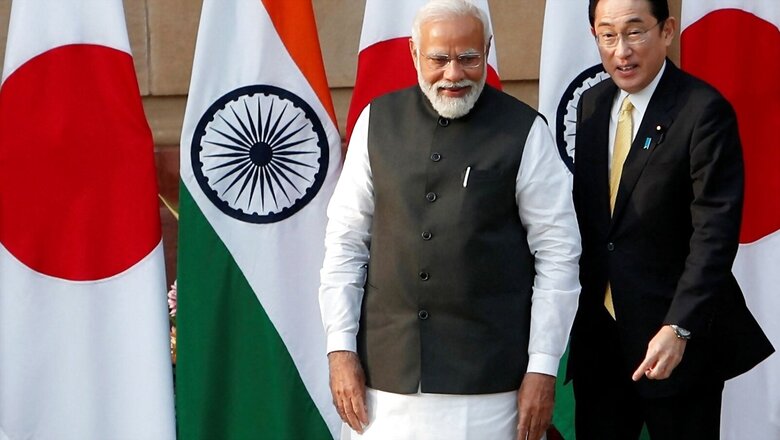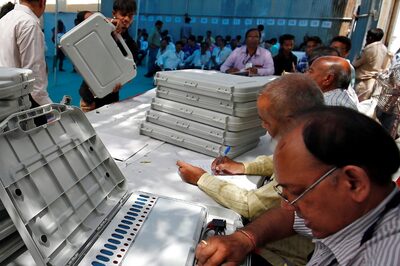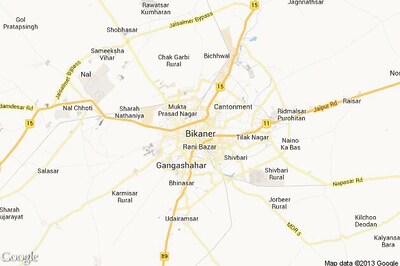
views
As the war continues to rage in Europe, India is maintaining an unrelenting focus on its Indo-Pacific engagements. Thus, on March 19, Prime Minister Modi hosted his Japanese counterpart Fumio Kishida for the latter’s first bilateral visit since assuming charge in October 2021. In the joint statement released after the meeting, both sides affirmed the “commitment to promoting peace, security, and prosperity in the Indo-Pacific”. Even the mention of the ongoing conflict in Ukraine occurred in the context of war’s “broader implications” for the Indo-Pacific region.
Similarly, though the joint statement released after a virtual meeting of the Indian and Australian Prime Ministers on March 21 mentioned the conflict and humanitarian crisis in Ukraine, the emphasis remained on “broader implications for the Indo-Pacific.” Following the virtual summit, the Indian Foreign Secretary confirmed in the press meet that the two countries agreed that the Ukraine crisis should not divert the Quad’s attention away from the Indo-Pacific region.
The findings of Takshashila’s new Global Outlook Survey help in understanding India’s growing push for the Indo-Pacific. The Survey was conducted through online polling in English between August and October last year. There were two sets of respondents: selected members of India’s strategic affairs community and the general public.
Also Read: Demonising India over Ukraine Won’t Help, West Needs Delhi by its Side in Indo-Pacific Contest
The survey reveals that in the geostrategic imagination of most Indians, the implications of China’s rise in the Indo-Pacific is one of the biggest strategic concerns. When asked to rank India’s biggest strategic challenges, China’s rise as a major power was the biggest concern for 13 per cent of the general population and 19 per cent of strategic affairs experts. In this regard, only the prospect of a slowing economy is seen as more challenging than China’s rise by both groups of respondents.
Notably, India’s continuing border crisis with China and the threat from the China-Pakistan axis are the most significant security concern for most Indians. For both the majority of the general population (53 per cent) and strategic experts (85 per cent), the disputed land boundary with China represents the biggest border security threat to India. In contrast, only 8 per cent of the general population and 4 per cent of strategic experts believe that the disputed land boundary with Pakistan is the biggest border security threat. This underlines how in the Indian threat perception, the border dispute with China has overtaken the border dispute with Pakistan. This shift was captured in General M.M. Naravane’s remarks in January 2020 that the Indian Army was keen on rebalancing its forces from the western front to the northern front.
Also Read: Japan and Australia Back India’s Push Against Biden’s Derailment of The Quad
The Survey also reveals that non-alignment/non-alliance is continued to be seen as an important tenet of the Indian foreign policy by one-third of the strategic affairs experts and one-fourth of the general population respondents. Thus, 22 per cent of experts and 15 per cent of the general population believe that a policy of non-alignment best serves India’s interests amid intensified Sino-US competition. Further, 15 per cent of the experts and 12 per cent of the general population express that India should never enter a formal military alliance with any state under any circumstances.
Interestingly, those respondents in the general population who prefer a more robust external balancing response against China remain divided on the suitable balancing partner. Thus, 17 per cent of the general population wants India to enter into a formal military alliance with the US, and another 17 per cent wants New Delhi to actively deepen economic and military ties with Russia to balance China. India’s Minister of State for External Affairs, Meenakshi Lekhi’s recent statement in the parliament that India’s relations with the US and Russia “stand on their own merit” is a testament to this indecisiveness.
When it comes to economic ties with China, the general population’s opinion (72 per cent) is united on the point that India should reduce its trade dependence, especially in the critical sectors. However, the view remains divided on whether or not such a reduction in trade dependence should lead to a broader decoupling in the long term. While 38 per cent of the general population believe that India should let the trade relationship develop organically while reducing overall trade dependence, another 34 per cent believe that India should pursue broader decoupling in the long term. The experts (74 per cent) also believe that India should reduce its trade dependence in critical sectors with China – with 52 per cent in favour of letting the trade relationship develop organically versus 22 per cent in favour of long-term decoupling.
The increasing centrality of the Indo-Pacific in Indians’ geostrategic outlook is reflected in the Survey. This is evident from the growing acceptance of the US as India’s most important strategic partner. For the general population, the India-US relationship (64 per cent) is the most important for India to achieve its strategic objectives, followed by India-Russia (12 per cent) and India-China (10 per cent). Similarly, for 85 per cent of experts, it is the India-US relationship that is the most important for the country’s strategic objectives, followed by India-Japan (7 per cent) and India-China (4 per cent).
When it comes to institutional arrangements in the Indo-Pacific, Indians are wary of the growing Chinese presence in the region. In this regard, the majority of the general population (50 per cent) and experts (63 per cent) disapprove of China’s participation in groupings like the Indian Ocean Rim Association and the Indian Ocean Naval Symposium. The Survey also highlights the rising importance of the Quadrilateral Security Dialogue (Quad) in the geostrategic outlook of most Indians. Thus, 57 per cent of the general population and 63 per cent of strategic affairs experts want the Quad to be formalised into an institutional mechanism with a permanent Secretariat. Further, when asked to prioritise dialogue frameworks for the Indian government, 57 per cent of the general population preferred Quad, followed by SAARC (17 per cent), BIMSTEC (12 per cent), BRICS (11 per cent), SCO (2 per cent) and RIC (1 per cent). Similarly, 70 per cent of experts prioritise Quad over SAARC (19 per cent) and BIMSTEC (11 per cent). None of the experts preferred dialogue frameworks involving China and Russia, such as BRICS, SCO and RIC.
When it comes to the future of the international order, both the overwhelming majority of the General Population (84 per cent) and Strategic Affairs Experts (63 per cent) believe that a multipolar order with an expanded UNSC best serves India’s interests. A US-led, rules-based international order is the second most favoured option both by the general population (14 per cent) and strategic experts (33 per cent). In contrast, a China-led, multipolar world order found no takers among the general population and strategic experts.
The survey corroborates the ongoing shift in the Indian geostrategic outlook. The growing distrust of China’s rising influence in the Indian neighbourhood, especially after the border conflict of June 2020, is pushing India to invest heavily in Indo-Pacific diplomacy. This leads to a call for a closer alignment with the US, an institutionalised upgrade for the Quad and disapproval of China’s greater role in the Indian Ocean.
Shrey Khanna is a Staff Research Analyst, Indo-Pacific Studies Programme, at The Takshashila Institution. The views expressed in this article are those of the author and do not represent the stand of this publication.
Read all the Latest Opinion News and Breaking News here




















Comments
0 comment